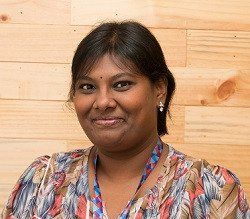HRDF: Playing A Role In Powering Up Malaysia’s SME Sector

SME Definition
Small and Medium Enterprises with sales turnover not exceeding RM50mil, or 200 workers for manufacturing; and RM20mil, or 75 workers for services and other sectors.
As jobs become more versatile and industries agile, the small and medium enterprises (SMEs) can be considered a saving grace for the most world economies including Malaysia’s.
Economies that are enveloped by uncertainties are constantly facing changes and require high flexibility to remain successful or stable. The nature of SMEs allows for such adaptability so that the industry remains resilient despite impending challenges.
The last SME Annual Report (2015/16) reveals that SMEs performed very well between 2011 and 2015. The SME GDP (gross domestic product) contribution as at 2015 – based on reports released by SME Corporation Malaysia last September – recorded a 6% growth from 2014. Overall the SME GDP contribution in 2015 was 36.3% which translates to 5% of the overall GDP.
The Economic Census 2011 shows that SMEs make up the bulk of businesses in Malaysia with a heavy concentration in service sectors including wholesale and retail for motor vehicles, food and beverage, real estate, education and other professional and technical services. This is followed by manufacturing, agriculture, construction and mining and quarrying, as demonstrated in Figure 1.

Figure 1. Profile of SMEs, Economic Census 2011. Source DOSM & SME CORP.
Even as the local economy faces an ambiguous future, SMEs seem to be riding the waves – even the rough ones – with conviction as the call for the survival heightens.
This might interest you: 5 Ways SMEs In Malaysia Can Grow
Identifying SME challenges
A World Bank report states that SMEs represent a whopping 97% of businesses in the country, making the sector the backbone of Malaysia’s economy. With such huge representation, great challenges are expected to sweep the sector into intricate complexities.
Challenges here include shortage and mismatch of skills, underrepresentation of women in businesses and a major lack of global competencies due to innovation and technological barriers.
The 2013 South-East Asian Economic Outlook Report also suggests that local SMEs are not only struggling with disparities in performance globally – due to the above challenges – but also locally, with an apparent gap between rural and urban SMEs, quite possibly due to limited infrastructure, resources and access to information.
There are ample initiatives being put in place to address these issues, particularly, skill shortages and mismatches that have a firm grip on the industry.
The SME Masterplan (2012-2020) is one major initiative that aims to improve the SME GDP contribution to 41% (from the current 36%) by identifying challenges faced by the sector and chartering plans to efficiently manage and overcome them.
This is where central agencies like Human Resources Development Fund (HRDF) comes into the picture, with a mass of programmes and initiatives, aimed at enhancing the capacity and capabilities of SMEs nationwide.
HRDF provides certification programmes, life-long learning opportunities, training needs analysis, skills training and funding opportunities to accelerate the growth of SMEs in the country.
Creating a ‘super’ workforce

Although total economic contribution by SMEs seems small, the industry accounts for 67% of total employment in Malaysia in 2015 (Economic Census 2011) but driving the sector to assume the responsibility of developing a skilled workforce remains a constant challenge.
HRDF plays a significant role as they’ve been mandated by the government to develop relevant reskilling and upskilling training programmes for the local workforce that can be achieved through HRDF’S Human Capital Strategic Initiatives.
HRDF’s chief executive Datuk CM Vignaesvaran Jeyandran says highly skilled human capital is important to keep the country’s economy relevant and competitive, globally.
“HRDF training and development programmes will not only equip workers with the right competitive skills but also the right attitude and awareness to face and adapt to industrial challenges,” says Vignaesvaran.
“Domestic businesses must embrace solutions to address skill shortages, talent mobility and talent retention in order to compete effectively in the new economic order driven by the Asean Economic Community,” he says.
He adds, the government’s move to fund reskilling and upskilling programmes will encourage employers to constantly engage professional bodies to train their employees.
Wondering how SMEs and the Malaysian economy will benefit from the above agenda? Well, over 80% of employers registered with HRDF are from the SME industry and according to Vignaesvaran, this includes the 17,585 employers from the manufacturing, services, mining and quarrying sectors.
The numbers are expected to rise with the recent expansion of the Human Resources Development Act 2001 (Akta Pembangunan Sumber Manusia 2001). Under the revised act, the number of Malaysians who are eligible for training under HRDF will gradually increase from the current 1.77 million to 2.8 million in the next three years.
Overall, HRDF is upskilling almost three million employees that will significantly increase the percentage of skilled workforce in Malaysia. Currently 28% of the nearly 15 million working population in Malaysia are considered skilled workers. The aim is to increase this to 35% by year 2020.
This places HRDF on high gear as they are not only creating a highly-skilled talent pool but a ‘super’ workforce that will drive Malaysia’s economy forward.
“HRDF is also planning on making it mandatory for SMEs in the manufacturing sector with 10 or more employees to register with us and subsequently be entitled to our training programmes as only those registered with us have access to our funds and programmes,” says Vignaesvaran.
With sufficient training, HRDF hopes SMEs can innovate, remain relevant and resilient in a volatile world.
Recommended reading: How Do You Evaluate Your SME’s Performance?
Powering up SMES
 Upscaling SMEs through training and development is a mammoth task. Business managers first need to understand the importance of these training programmes. They then, have the task of ensuring their employees are given the opportunity and access to these training.
Upscaling SMEs through training and development is a mammoth task. Business managers first need to understand the importance of these training programmes. They then, have the task of ensuring their employees are given the opportunity and access to these training.
HRDF has made it easy for businesses to have access to funding and resources. In fact, to ease the process, the agency also run Training Needs’ Analysis to determine the problems faced by these businesses and match them with suitable training programmes to address their immediate needs before delving further.
HRDF’s SME Training Partner Scheme equips SME employees with specialised skills in the following areas of interest;
- Specialised programmes such as the SME Technovation & Productivity Programme
- Human resources management
- Training of internal trainers (train the trainers)
- Upskilling training programmes
Another HRDF initiative that helps SMEs is their “On The Job Training” (OTJ), where a skilled a worker is paid to train a new or unskilled employee without having to send the employee out for external training programmes. Employers can claim the additional ‘training’ payment provided that the OTJ meets all the set criteria.
Holding true to its vision of becoming the main human capital development authority in the country, HRDF provides human resource development solutions via funding, assessments, skill enhancement trainings, education and promotional programmes. To learn more about their initiatives and how you can grow your business, call 1-800-88-4800 or visit www.hrdf.com.my
Business
Tags: Growth, Business Model, Succession Planning, Business Management









